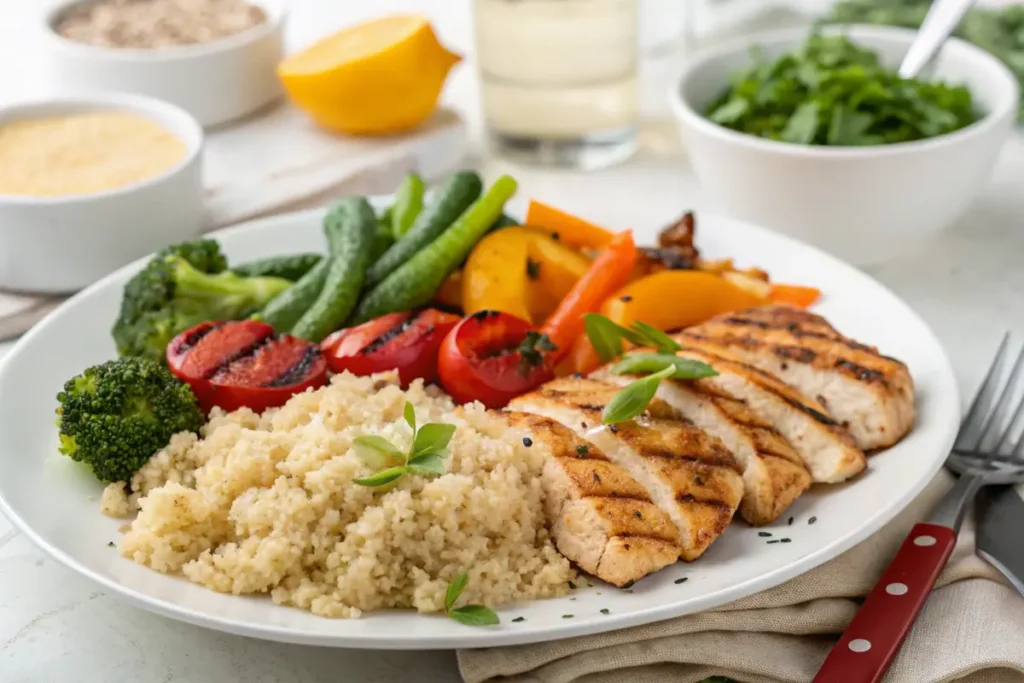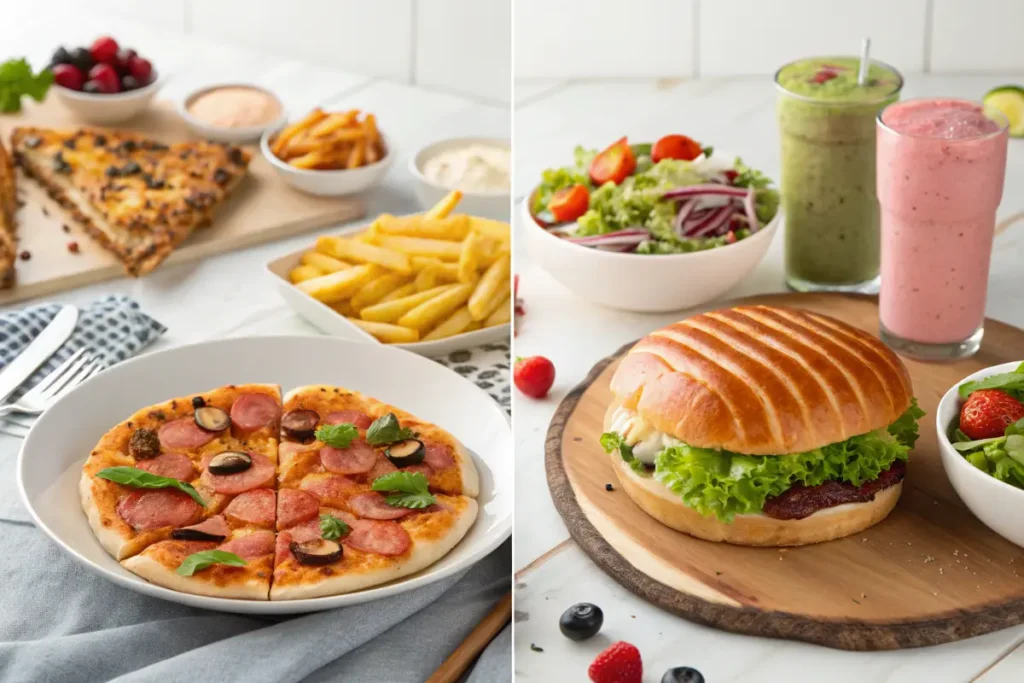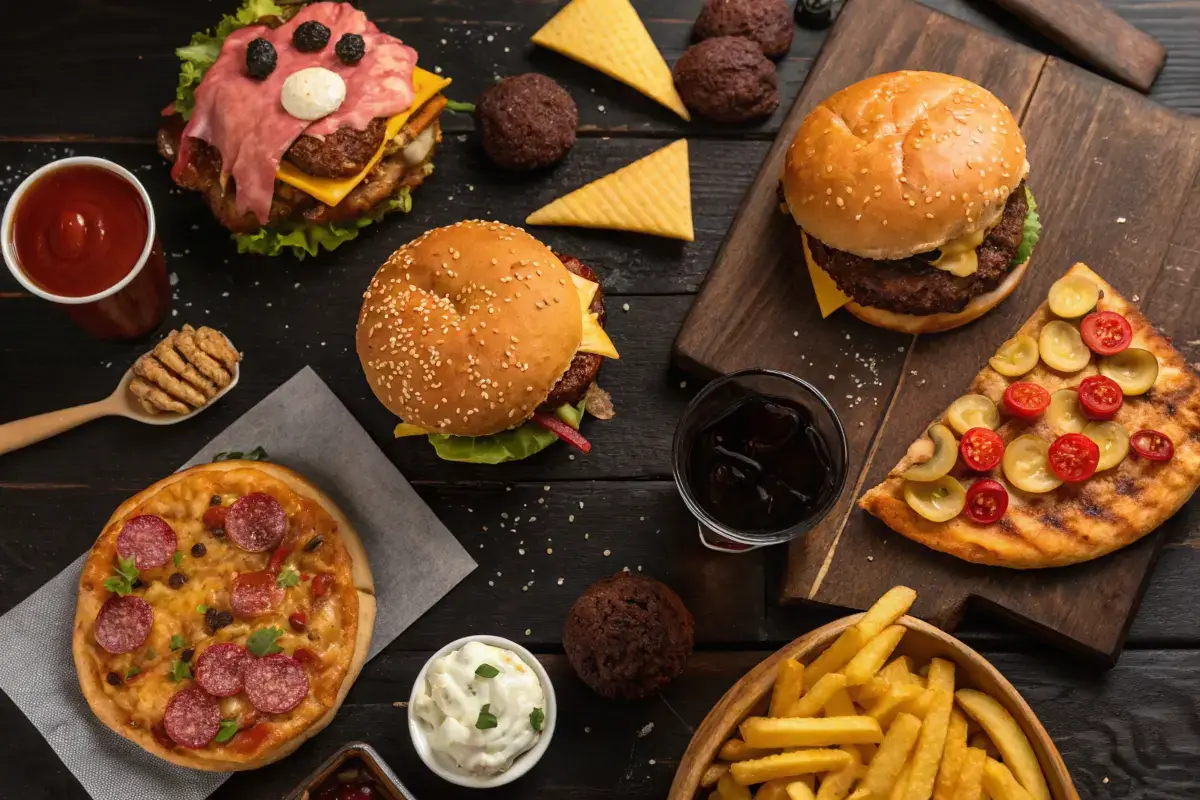Fattening foods are a hot topic when it comes to nutrition, weight management, and health. While some high-calorie foods can support healthy weight gain, others are notorious diet busters packed with empty calories. This article explores the science behind fattening foods, their effects on the body, and practical tips for managing them in your diet. We’ll dive into the most fattening foods to avoid, healthier alternatives, and ways to strike a balance between indulgence and nourishment. Let’s unravel the complexities of calories, nutrients, and weight gain step by step.
What Are Fattening Foods?
Defining Fattening Foods
Fattening foods are those that pack a punch when it comes to calories but often lack essential nutrients. Typically, these foods are high in saturated fats, refined sugars, and processed ingredients, making them calorie-dense and nutrient-poor. While not all calorie-rich foods are unhealthy, the ones low in vitamins, fiber, and protein tend to contribute to unhealthy weight gain.
But what sets fattening foods apart? It’s their ability to tip the scale toward a calorie surplus—when you consume more calories than you burn, leading to weight gain. Foods like sugary drinks, fried snacks, and baked goods can easily fit this description, thanks to their combination of high energy content and low satiety.
Calories and Their Role in Weight Gain
At the heart of weight gain is the concept of calories. Simply put, calories are the energy your body uses to function. Consuming more calories than your body burns leads to storing the excess as fat. For instance, one gram of fat contains nine calories, while proteins and carbs each contain four. The math isn’t hard—eat more than you burn, and the result is added pounds.
However, not all calories are created equal. Calories from empty-calorie foods, such as soda or candy, contribute to weight gain without providing the fiber, protein, or micronutrients your body needs. By contrast, whole foods like avocados and nuts are calorie-dense but packed with essential nutrients.
Empty Calories: The True Culprits
Here’s where it gets tricky: empty calories are the biggest villains in the weight-gain saga. These are calories from foods or drinks high in sugar, unhealthy fats, or alcohol with minimal nutritional value. For example, a single can of soda can contain over 150 calories, yet it offers zero vitamins or minerals.
Empty-calorie foods don’t just lead to weight gain—they also leave you feeling unsatisfied. This happens because they lack protein and fiber, which are essential for keeping you full. Worse yet, they can cause cravings for even more sugary or fatty foods, creating a vicious cycle.
The Top 10 Most Fattening Foods to Avoid
Deep-Fried Foods: Why They Top the List
Deep-fried foods, like French fries and fried chicken, are notorious for being high in calories, unhealthy fats, and salt. The frying process adds significant fat content, turning otherwise healthier options into diet disasters. Studies have shown that frequent consumption of fried foods is linked to obesity and heart disease. Opt for baked or air-fried alternatives to satisfy your cravings without the excessive calorie load.
Fast Food Burgers: Hidden Calories in a Bun
While a homemade burger can be nutritious, fast-food versions are loaded with empty calories, saturated fats, and refined carbs. Toppings like cheese, sauces, and bacon add even more calories. Eating such burgers regularly can push you into a calorie surplus, leading to weight gain. Want a healthier version? Try using whole-grain buns, lean meat, and plenty of veggies.
Pizza: Delicious but Dangerous
Pizza is a classic comfort food, but most varieties are made with refined flour, processed meats, and lots of cheese, making them high in calories and saturated fats. Thin-crust pizzas topped with fresh vegetables and lean proteins are a better option for those mindful of their health.
Sugary Beverages: Liquid Calories and Their Impact
Sugary drinks, such as sodas, sweetened teas, and energy drinks, are some of the biggest contributors to weight gain. These beverages are packed with added sugars, offering no fiber or protein to balance their calorie content. Consider switching to water, herbal teas, or sparkling water for hydration without the sugar overload.
Ice Cream: High in Sugar and Fats
Everyone loves a scoop of ice cream, but its high sugar and fat content can easily derail your diet. Regular consumption is linked to weight gain, especially when eaten in large portions. For a healthier alternative, try fruit-based sorbets or homemade “nice cream” made with bananas.
Alcohol: Weight Gain and Hidden Sugars
Alcoholic beverages, particularly cocktails and beer, are calorie-dense but nutrient-poor. Heavy drinking not only adds calories but also increases your appetite for salty and fatty snacks, compounding the issue. Opt for lighter choices, like a vodka soda or a glass of red wine, if you’re indulging.
Baked Goods: Sugar Bombs in Every Bite
Pastries, muffins, and cookies might be tempting, but they’re loaded with added sugars and unhealthy fats. These treats are also low in fiber and protein, which means you’re more likely to overeat them without feeling full. Consider healthier snacks like oatmeal cookies or protein-packed energy bites.
White Bread and Pasta: Refined Carbs and Low Fiber
Refined carbs in white bread and pasta digest quickly, causing blood sugar spikes and leaving you hungry again soon after. Whole-grain versions are higher in fiber, keeping you full for longer and preventing overeating.
Processed Snacks: Salty and Caloric Overload
Chips, crackers, and other processed snacks are often fried, loaded with salt, and highly caloric. These foods offer little nutritional value and are easy to overconsume. Swap them out for air-popped popcorn or crunchy veggies with hummus.
Candy and Sweets: Empty Calories at Their Peak
Candies and sweets like chocolates and gummies are pure sugar with little to no nutritional benefit. They provide a quick energy boost but lead to sugar crashes and increased hunger later. Try satisfying your sweet tooth with fresh fruit or a piece of dark chocolate.
Healthy Fattening Foods for Weight Gain
Why Healthy Weight Gain Matters
Not all fattening foods are bad! For those looking to gain weight or build muscle, nutrient-dense, high-calorie foods are essential. These foods provide the necessary energy and nutrients to support healthy growth without the risks associated with junk food.
Nutrient-Dense High-Calorie Foods
Foods like avocados, nuts, and seeds are packed with healthy fats, protein, and fiber, making them ideal for healthy weight gain. Incorporate them into salads, smoothies, or snacks for a calorie boost that supports overall health.
Dairy Products: Milk, Cheese, and Yogurt
Dairy is an excellent source of calcium and protein, which are vital for bone health and muscle building. Full-fat yogurt and cheese are especially helpful for adding calories without resorting to unhealthy options.
Animal Proteins: Lean Meats and Fatty Fish
Lean meats, like chicken and turkey, provide a clean source of protein without excessive fat. Fatty fish, such as salmon, adds omega-3 fatty acids, which are crucial for brain and heart health while supporting healthy weight gain.
For more meal inspiration, consider exploring high-protein meal ideas, which offer a balanced approach to gaining weight without sacrificing nutrition.
The Science of Weight Gain and Calories
The Energy Equation: Calorie Surplus vs. Deficit
Understanding the relationship between calorie intake and energy expenditure is crucial when discussing fattening foods. A calorie surplus occurs when you consume more calories than your body needs, leading to weight gain. This excess energy is stored as fat, regardless of whether it comes from carbs, fats, or proteins. On the flip side, a calorie deficit—where you burn more calories than you consume—promotes weight loss.
However, not all calories are equal. Calories from nutrient-dense foods like whole grains and lean proteins are more beneficial than those from sugary or processed foods. They fuel your body while supporting muscle development and overall health. To maintain a healthy weight, focus on the quality of your calories as much as the quantity.
Macronutrients and Their Caloric Impact
The three macronutrients—carbohydrates, proteins, and fats—play different roles in weight management. While one gram of fat contains 9 calories, both proteins and carbs provide 4 calories per gram. Fats are more calorie-dense, which is why foods high in unhealthy fats are often labeled as fattening foods.
Carbs, particularly refined ones, can cause quick spikes in blood sugar, leading to increased appetite and potential weight gain. On the other hand, proteins require more energy to digest and keep you full longer, making them ideal for maintaining or losing weight.
Psychological and Physical Effects of Overeating
Eating too many fattening foods can affect your body and mind. Physically, it may lead to weight gain, inflammation, and even health conditions like type 2 diabetes. Psychologically, excessive consumption of sugar and unhealthy fats can contribute to cravings and emotional eating. Being mindful of portion sizes and choosing nutrient-rich foods can help break this cycle.
For balanced meal ideas that prioritize nutrition, explore our healthy dinner recipes, offering easy options for wholesome eating.
How to Manage Fattening Foods in a Healthy Diet
Portion Control: Eating Without Overindulgence
One of the best ways to enjoy fattening foods without gaining weight is through portion control. Even high-calorie treats can fit into a healthy diet when consumed in moderation. For instance, instead of eating an entire pizza, savor a slice alongside a fresh salad. Managing portion sizes not only prevents overeating but also lets you enjoy your favorite foods guilt-free.
Healthy Alternatives to Fattening Foods

Making simple swaps can help you enjoy the flavors you love without the excess calories. Replace deep-fried snacks with air-fried versions, sugary drinks with infused water, or creamy sauces with yogurt-based alternatives. These changes reduce calorie intake while keeping your meals delicious and satisfying.
If you’re looking for specific ideas, check out our healthy baking recipes, where you’ll find guilt-free options like sweet potato brownies and protein-rich muffins.
Meal Planning for Balanced Nutrition
Planning meals in advance can help you avoid relying on fattening foods for convenience. Start by including a mix of lean proteins, whole grains, and plenty of vegetables in your weekly meal prep. By keeping nutritious options on hand, you’ll be less tempted to reach for high-calorie, low-nutrient snacks.
Meal planning can be especially helpful if you have specific health goals. For inspiration, browse our meal prep ideas for muscle building. These recipes are tailored to support a balanced, high-protein diet.
FAQs About Fattening Foods
What Foods Are Considered the Most Fattening?
Foods with high calorie content but little nutritional value are often labeled as fattening foods. These include sugary drinks, fried snacks, pastries, and processed meals. What makes these foods particularly problematic is their lack of fiber and protein, which are essential for feeling full. As a result, people often consume more calories than they need without realizing it.
Can Fattening Foods Be Part of a Healthy Diet?
Yes, even fattening foods can have a place in a balanced diet when consumed in moderation. For example, enjoying a slice of pizza or a scoop of ice cream occasionally is unlikely to derail your health goals. The key is to pair indulgent choices with healthier options, like fresh vegetables or lean proteins, and to practice portion control.
How Do Fattening Foods Affect the Skin?
Unhealthy fattening foods, such as those high in sugar or fried in unhealthy oils, can contribute to skin issues like acne. They may cause inflammation and disrupt hormonal balance, leading to breakouts or dull skin. To maintain healthy skin, focus on a diet rich in fruits, vegetables, and healthy fats, like those found in avocados and nuts.
What Foods Help with Weight Loss or Healthy Weight Management?
Whole, nutrient-dense foods such as leafy greens, lean proteins, and whole grains are excellent for weight management. They provide essential nutrients without adding empty calories, unlike fattening foods. Swapping sugary snacks for fresh fruit or salty chips for air-popped popcorn can also help you stay on track.
Conclusion: Making Informed Food Choices
Understanding Food’s Role in Health
When it comes to managing your diet, knowledge is power. Recognizing which fattening foods contribute to unhealthy weight gain can help you make better choices. However, the goal isn’t to avoid all high-calorie foods—it’s about selecting nutrient-dense options that nourish your body while keeping your energy levels stable.
Tips for Maintaining a Balanced Diet
Achieving balance starts with small, manageable steps. Focus on eating a variety of whole foods, including fruits, vegetables, lean proteins, and whole grains. When indulging in fattening favorites like pizza or desserts, practice portion control and balance them with lighter meals. Hydration, regular exercise, and meal planning also play a vital role in maintaining a healthy lifestyle.
Remember, it’s not about being perfect but making thoughtful choices. With a balanced approach, you can enjoy your favorite foods while staying healthy and happy.
Practical Tips to Minimize the Impact of Fattening Foods
Eat Mindfully to Avoid Overeating
Mindful eating is one of the simplest ways to reduce the impact of fattening foods on your diet. Pay attention to your hunger cues and savor every bite. Eating slowly allows your brain to catch up with your stomach, helping you avoid overindulging. This practice is especially helpful when enjoying calorie-dense treats like desserts or fried foods.
Pair Fattening Foods with Healthier Options

Balancing indulgent foods with nutrient-dense ones can reduce their negative effects. For instance, serve a slice of pizza with a side of leafy greens, or enjoy a small portion of fries alongside grilled chicken. This approach ensures that you’re still getting essential vitamins and fiber without overloading on calories.
Stay Active to Balance Calorie Intake
Physical activity can counteract the calorie surplus caused by fattening foods. A brisk walk after a meal or regular gym sessions can help burn excess calories and maintain a healthy weight. Even small actions, like taking the stairs or stretching, can make a difference over time.
The Long-Term Effects of Fattening Foods on Health
Weight Gain and Obesity
It’s no secret that regular consumption of fattening foods can lead to weight gain. Foods high in sugar, unhealthy fats, and refined carbs contribute to excess calorie intake, making it difficult to maintain a healthy weight. Over time, this can increase the risk of obesity and related health issues, such as diabetes and heart disease.
Increased Risk of Chronic Diseases
Beyond weight gain, a diet rich in fattening foods may have long-term impacts on overall health. High sugar intake is linked to type 2 diabetes, while unhealthy fats can lead to high cholesterol and cardiovascular problems. Processed foods, in particular, are often loaded with sodium and preservatives that may contribute to high blood pressure.
Breaking the Cycle of Unhealthy Eating
The good news is that making small, consistent changes can reverse the effects of fattening foods on your body. Gradually replacing processed snacks with whole foods, cooking more at home, and drinking water instead of sugary beverages can lead to significant health improvements over time.
For inspiration, check out our healthy recipe ideas for meals that are both delicious and nutritious.

